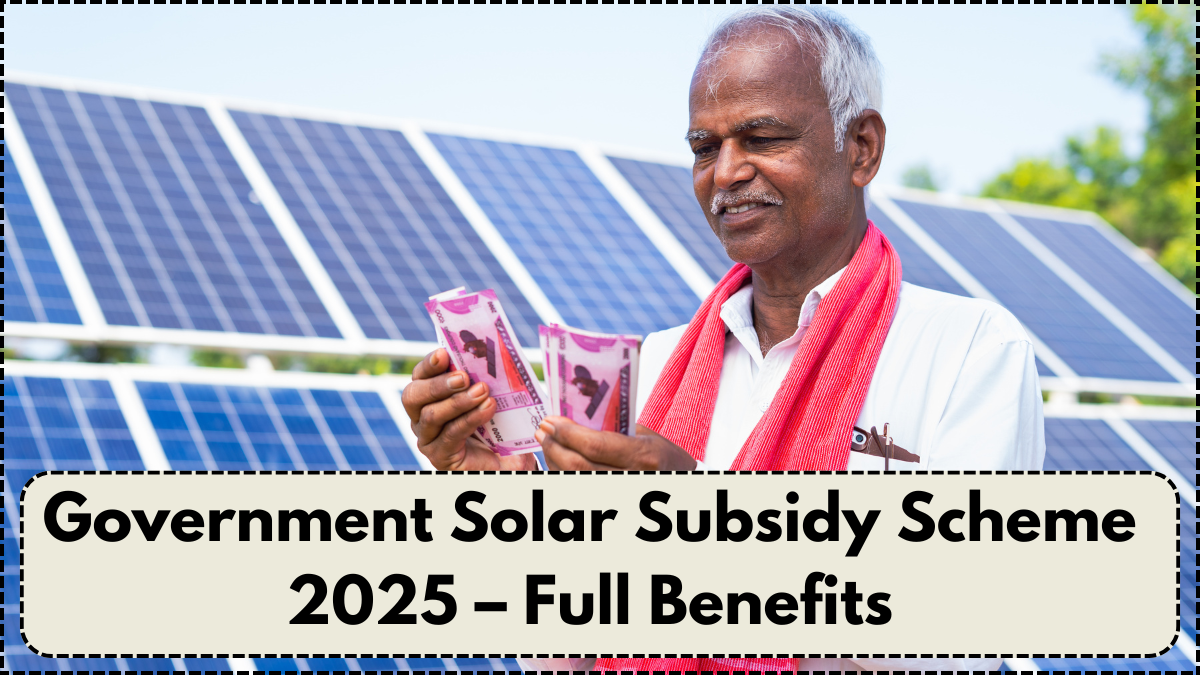The Indian government is continuing its push for clean energy adoption through the Govt Solar Subsidy India 2025 program. With a rising demand for sustainable power sources and efficient power backup options, this scheme is designed to help households, farmers, and small businesses install solar energy systems at reduced costs. The year 2025 brings upgraded benefits, wider eligibility, and streamlined processes for subsidy application.
This initiative aligns with India’s goal to achieve 500 GW of non-fossil fuel capacity by 2030. It also supports rural electrification and reduces dependency on diesel generators. Let’s dive deeper into the key features and advantages of this program.

What’s New in the Govt Solar Subsidy India 2025?
The Govt Solar Subsidy India 2025 includes higher financial aid and better integration with local distribution companies (DISCOMs). The new version is focused on expanding residential and agricultural solar rooftop installations.
Key features include:
-
40% subsidy for residential rooftop systems up to 3 kW
-
Special subsidy category for farmers with irrigation needs
-
Support for hybrid systems that act as power backup
-
Digital application and tracking through national solar portals
-
Push for adoption of lithium-ion battery-based storage
With these updates, the program encourages faster adoption in both urban and rural sectors.
Benefits of the 2025 Solar Subsidy Scheme
The revamped subsidy scheme ensures users enjoy both environmental and financial gains. Some of the direct benefits include:
-
Lower upfront cost for solar panel installation
-
Monthly electricity savings for 25+ years
-
Reduced carbon footprint
-
Eligibility for net metering, allowing extra electricity to be sent back to the grid
-
Reliable power backup during grid failures
This combination of advantages makes solar energy a smart long-term investment.
Who Can Apply for the Subsidy?
The eligibility for the Govt Solar Subsidy India 2025 has been broadened to include a wider user base:
-
Homeowners in rural and urban India
-
Farmers with borewell or irrigation needs
-
MSMEs with rooftop space
-
Residential societies or housing complexes
-
Educational institutions and small commercial setups
Applicants must use approved vendors and adhere to MNRE (Ministry of New and Renewable Energy) guidelines.
Solar Panel Subsidy Rates Comparison
Here’s a table showing updated subsidy amounts for various user categories:
| Category | System Capacity | Subsidy Offered | Remarks |
|---|---|---|---|
| Residential Rooftop | Up to 3 kW | 40% of benchmark cost | Flat rate across India |
| Farmers (Irrigation use) | Up to 5 kW | 30% + 20% State add-on | Subject to state cooperation |
| MSMEs | Up to 10 kW | 20% | Must have grid connectivity |
| Housing Societies | Shared rooftop use | 30% (capped per flat) | Limited to 50 flats |
The combination of central and state subsidies can significantly reduce installation costs.
How to Apply for Govt Solar Subsidy in 2025
Applying for the Govt Solar Subsidy India 2025 is easier than ever:
-
Visit the MNRE national solar portal
-
Register your DISCOM account and meter details
-
Choose a listed vendor from the approved list
-
Submit the application and wait for approval
-
On successful inspection, subsidy is credited directly to the vendor
Digital tracking tools allow you to monitor your subsidy status in real-time.
Conclusion
The Govt Solar Subsidy India 2025 scheme is a game-changer for clean energy adoption. Whether you’re looking for efficient power backup or sustainable electricity alternatives, this scheme provides the financial and structural support needed. With rising electricity costs and climate concerns, solar power isn’t just a good idea—it’s a necessary one.
If you’re planning to install a rooftop solar system this year, now is the perfect time to leverage these benefits and save on both electricity bills and upfront costs.
FAQ
What is the subsidy percentage under Govt Solar Subsidy India 2025?
The central subsidy provides up to 40% for residential systems up to 3 kW, with additional state subsidies available in some regions.
Can farmers apply for solar subsidy?
Yes, farmers can receive up to 50% subsidy when combining central and state schemes for irrigation-based solar setups.
Does the subsidy cover batteries for power backup?
Yes, hybrid systems with approved battery storage (like lithium-ion) are eligible under the scheme.
How long does it take to get the subsidy?
Once the system is installed and verified, the subsidy is generally processed within 30–60 days.
Is there an income limit to qualify for this scheme?
No income criteria apply for residential or farmer categories. Any eligible user can apply under this scheme.
Click here to know more